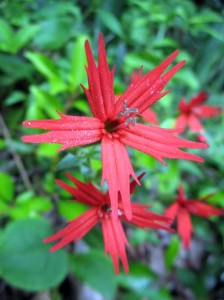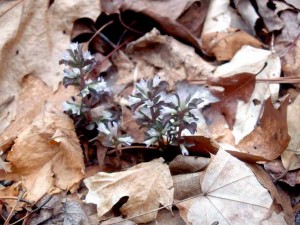North Carolina’s Natural Gardens

Discovering the fire pink in Ohio in his high school days led B.W. Wells on a lifetime pursuit of botanical studies in North Carolina. Photo by Tom Wentworth.
By Ken Moore
In 1932, The Natural Gardens of North Carolina, written by Dr. Bertram Whittier (B.W.) Wells, professor of botany at N.C. State University, was published by the University of North Carolina Press. How well I remember back in 1966, my mentor presenting me with a copy of Natural Gardens with the comment, “If you are going to study the botany of North Carolina, then you need to become acquainted with B. W. Wells!†That began for me a lifelong pursuit of discovering and enjoying the natural gardens of our state.
As a high school freshman in Ohio, Wells, with the help of a plant key, saw and identified a fire pink, Silene virginica, a brilliant-red wildflower we see here in early May. He later described that experience: “From that moment on I knew what my life’s work would be. I was so terribly excited about identifying that flower.… The more you see, the more you have to see.â€
Wells received his Ph.D. at the University of Chicago and in 1919 accepted an appointment at what was then N.C. State College, where he remained as head of the botany department until 1949 and a professor until 1954.
He was inspired and challenged by the beauty and diversity of North Carolina

plants and plant communities. An engaging teacher and a competent researcher, Wells made great contributions to the new discipline of plant ecology. For him, the diversity of seasonal wildflower displays in distinct plant communities across the state were, indeed, spectacular natural gardens. He was an excellent communicator and writer. Natural Gardens, republished by UNC Press in 1996, is a very readable description of the state’s natural vegetation, from the ocean spray dunes to the high-mountain evergreen forests.
Some of Wells’ notable observations include salt-spray effects on dune vegetation, a possible meteorite origin of the hundreds of elliptical-shaped Carolina bay lakes and bogs in the coastal plain and Native American burning practices as a possible origin of high-mountain grassy balds. He encouraged nurserymen to propagate the great variety of native plants for home-garden and urban-landscape use. He was way ahead of his time!
In retirement, Wells remained physically active, farming an old homestead, Rock Cliff Farm, above a dramatic bend of the Neuse River near Wake Forest. When not engaged in farm work or laying out walking trails through his natural gardens, he painted with water colors, oils and pastels, over 100 beautiful portraits of the state’s natural gardens, including his own farm.
With support from the B.W. Wells Association, Rock Cliff Farm is now preserved as part of the Falls Lake State Recreational Area. The farm, including his self-built artist studio and miles of trails, are not generally open to the public, so B.W. Wells Heritage Day this Saturday is a great opportunity to visit. Refer to bwwells.org for directions and descriptions of day-long activities, including wildflower, geology and heritage farm tours and special activities for children.
As I was counseled years ago, if you want to appreciate the real “nature†of our state, you need to become acquainted with B. W. Wells and The Natural Gardens of North Carolina. Some of those natural gardens are at Rock Cliff Farm. “The more you see, the more you have to see.â€



Comments are closed.